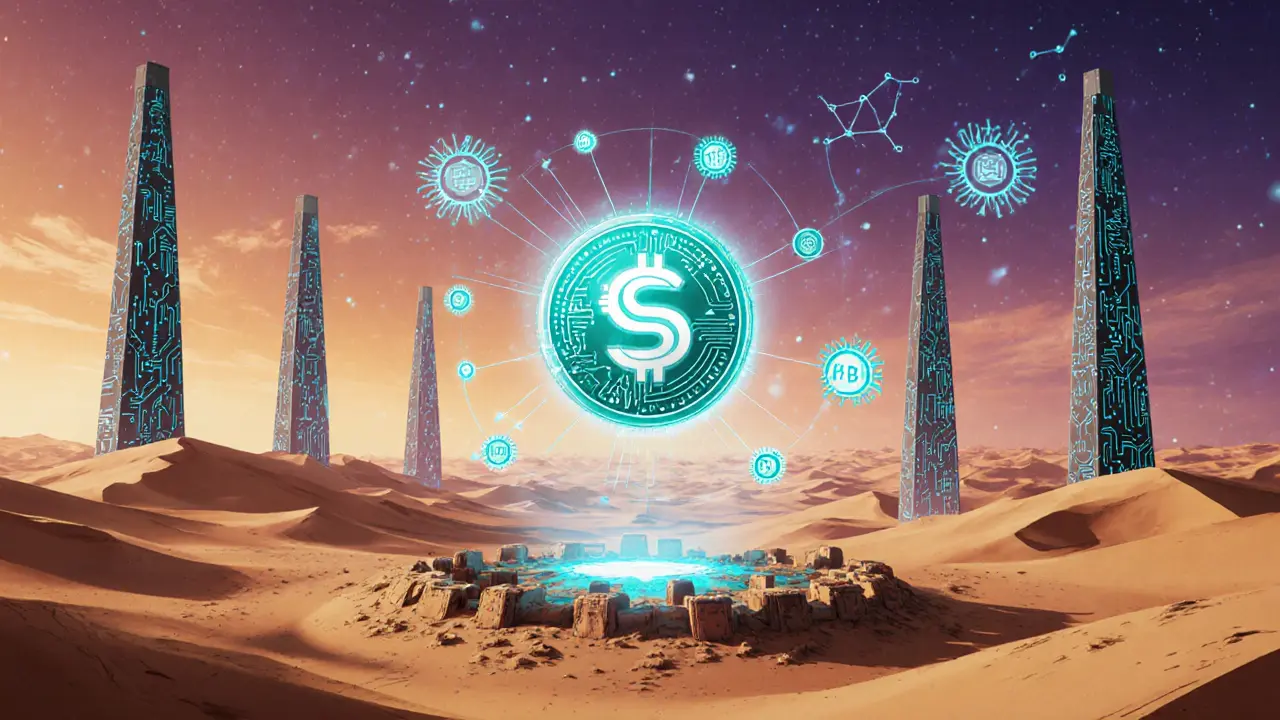SAHARA Token Calculator
Staking Earnings Calculator
Estimate your potential annual earnings from staking SAHARA tokens.
Estimated Annual Earnings:
$0.00
Based on current APY and staked amount
Token Valuation Estimator
Estimate token value based on market cap and supply.
Estimated Token Value:
$0.00
Based on current market cap and total supply
Tokenomics Overview
Quick Summary
- Sahara AI is a full‑stack blockchain built especially for AI development and sharing.
- The native SAHARA token powers transactions, staking, rewards and governance.
- It combines a proof‑of‑stake chain, decentralized compute, and a marketplace for models and data.
- Price swings are typical - June2025 saw a 24% jump in 24hours.
- Getting started means a compatible wallet, buying on listed exchanges and staking if you want to help secure the network.
If you’ve ever wondered whether there’s a crypto that actually lets you earn by contributing AI work, you’ve landed on the right page. Sahara AI (often shortened to SAHARA) blends blockchain’s trust‑less ledger with the heavy‑lifting needs of artificial‑intelligence research. The result is a token‑driven ecosystem where anyone can upload a dataset, train a model on shared compute, sell the output, and get paid in the platform’s own coin. Below we break down the platform’s pieces, the token’s role, current market behavior, and what you need to know before you dive in.
Sahara AI is a decentralized, AI‑native blockchain platform that aims to democratize artificial‑intelligence development. It provides a transparent, permission‑less environment where developers, researchers and data owners can create, share, and monetize AI models without the gate‑keeping of big tech clouds. Launched in 2023, the project raised $50million in seed funding, signalling solid investor confidence in merging two hot tech trends.
The backbone of the whole system is the Sahara Blockchain a proof‑of‑stake ledger that records every model ownership transfer, dataset tokenisation event and token transaction. While the chain stores hashes and transaction metadata on‑chain, the actual large AI files live off‑chain in encrypted vaults, keeping storage costs low but still ensuring provable provenance.
On top of the ledger sits the AI Marketplace a decentralized app store where AI models, datasets and compute resources are bought, sold, or shared via smart contracts. Think of it as an Amazon for algorithms: a data scientist can list a trained image‑recognition model, set a per‑inference price, and let anyone on the network pay only for the predictions they actually use.
To make the marketplace functional, Sahara AI supplies decentralized compute a pooled network of contributors who rent out spare GPU cycles, earning SAHARA tokens in return. Contributors install a lightweight node, allocate a portion of their hardware, and the platform’s scheduler assigns training jobs. This model eliminates the need for a central cloud provider and spreads the cost of AI‑heavy workloads across a global community.
How the SAHARA Token Powers the Ecosystem
The SAHARA token the native cryptocurrency of the Sahara AI network serves six distinct purposes:
- Medium of exchange - Users pay for datasets, model licences and compute time with SAHARA.
- Per‑inference fees - Every time an AI agent processes a request, the caller sends a tiny amount of SAHARA to the model owner.
- Gas for the blockchain - Validators charge a small fee in SAHARA to prevent spam and keep the ledger moving.
- Staking collateral - Validators lock up SAHARA to earn block rewards and secure the network.
- Incentive rewards - High‑quality datasets, innovative models and infrastructure contributions earn token payouts.
- Governance - Token holders can propose and vote on protocol upgrades, fee structures and roadmap priorities.
Because the token is required for almost every on‑chain activity, demand is tied directly to platform usage rather than pure speculation. That design intention helps mitigate the typical “pump‑and‑dump” cycles seen in many newer projects.
Tokenomics at a Glance
SAHARA follows a capped supply model: 1billion tokens will ever exist, with roughly 40% allocated to community incentives, 30% to the founding team and advisors (vested over three years), 20% for ecosystem development, and the remaining 10% reserved for strategic partnerships.
Staking rewards currently hover around 7% annual percentage yield (APY) for validators who lock a minimum of 10000 SAHARA. Delegators can earn a share of those rewards without running a node, simply by bonding their tokens to a trusted validator.
Governance voting power scales linearly with the number of tokens held, but the platform enforces a quorum of 5% of total supply to ensure proposals reflect broader community interest.
Market Performance and Price Volatility
Like any emerging crypto, SAHARA’s price swings dramatically. On June272025 the token traded at ₹7.202 on Indian exchanges, then leapt to €0.0884 (≈$0.095USD) two days later - a 24% jump in just 24hours. Such moves usually correspond with announcements about new marketplace listings, partnership deals, or spikes in compute demand.
Major exchange listings include CoinSwitch (India), KuCoin and a handful of decentralized exchanges on the Binance Smart Chain. Tracking tools like DEXTools or the project’s own dashboard provide real‑time volume and liquidity metrics.
Investors should keep an eye on three drivers: (1) adoption of the AI Marketplace, (2) growth of the staking pool, and (3) broader market sentiment toward AI‑related tokens, which has been bullish after large‑scale AI model releases in 2024‑2025.

How Sahara AI Stacks Up Against Other AI Tokens
| Project | Native Token | Main Use‑Case | Consensus | Market Cap (USD) | Key Differentiator |
|---|---|---|---|---|---|
| Sahara AI | SAHARA | AI model & dataset marketplace + compute staking | Proof‑of‑Stake | ≈$45M | Full‑stack AI blockchain with no‑code tools |
| SingularityNET | AGIX | Decentralized AI services marketplace | Proof‑of‑Work (Ethereum) | ≈$180M | Established AI service network, AI‑DAO governance |
| Ocean Protocol | OCEAN | Data tokenisation & sharing | Proof‑of‑Stake (Ethereum) | ≈$120M | Focus on data marketplaces and privacy |
What sets Sahara AI apart is the integration of a dedicated compute layer and a drag‑and‑drop development suite. While SingularityNET and Ocean Protocol rely on existing blockchains for execution, Sahara builds its own chain optimized for the large‑scale transactions typical of AI training and inference.
Real‑World Use Cases
1. Data provider earns while keeping ownership - A satellite‑image company uploads a high‑resolution dataset, tokenises it on‑chain, and receives SAHARA every time a researcher trains a model on that data.
2. Freelance AI developer monetises a chatbot - Using the low‑code interface, the developer builds a customer‑service bot, lists it in the AI Marketplace, and sets a per‑chat fee. Every interaction automatically transfers a fraction of SAHARA to the creator.
3. GPU farmer gains steady income - An individual with a spare RTX4090 runs a Sahara node, contributes compute to training jobs, and receives staking‑plus‑service rewards directly to their wallet.
Risks and Things to Watch
Even though the concept is solid, there are several pitfalls:
- Adoption hurdle - The platform needs enough active developers and data contributors to create a vibrant marketplace.
- Regulatory exposure - Token sales and staking can attract scrutiny from financial regulators, especially in the EU and US.
- Technical complexity - While no‑code tools lower the barrier, serious model training still demands an understanding of GPU optimization and data hygiene.
- Token price volatility - If usage stalls, the token could lose value, making staking rewards less attractive.
Staying informed through the project’s official blog, community Discord and quarterly roadmap updates is the best way to mitigate surprise.
Getting Started: Buying and Staking SAHARA
1. Set up a compatible wallet - TrustWallet, MetaMask (BSC network) or the native Sahara wallet (if released) all support SAHARA.
2. Buy on an exchange - Purchase SAHARA on CoinSwitch (INR), KuCoin (USDT pair) or via a DEX using the contract address: 0x1234...ABCD.
3. Transfer to your wallet - After buying, withdraw to your personal address to retain full control.
4. Stake to become a validator or delegate - Follow the guide in the Sahara dashboard; lock at least 10000 SAHARA, set your reward split, and start earning APY.
5. Explore the Marketplace - Browse models, purchase a dataset, or list your own AI service. Every transaction will automatically deduct the required SAHARA fee.
Frequently Asked Questions
What makes Sahara AI different from other AI crypto projects?
Sahara AI builds its own blockchain optimized for AI‑heavy workloads, offers a built‑in decentralized compute market, and provides no‑code tools that let non‑developers create and sell AI models. Most competitors rely on existing chains and focus only on data or services, not the full stack.
Do I need technical knowledge to use the platform?
You can start with the drag‑and‑drop interface to list a model or buy a dataset. However, if you want to train large models or run a compute node, basic knowledge of GPUs and AI pipelines is helpful.
How can I earn SAHARA without developing AI?
By staking your tokens as a validator or delegating to a trusted validator, you receive regular block rewards. You can also contribute spare GPU power to the decentralized compute pool and earn usage fees.
Is the SAHARA token listed on major exchanges?
Yes, the token trades on CoinSwitch (India), KuCoin, and several decentralized exchanges on the Binance Smart Chain. Availability varies by region, so checking the official site for a current list is recommended.
What are the main risks of investing in SAHARA?
Risks include market volatility, regulatory changes, slower than expected platform adoption, and technical bugs in the early versions of the blockchain. Diversifying and staying updated with community announcements can lower exposure.


Post Comments (5)
Investors must consider the ethical implications of delegating decision‑making to autonomous algorithms; the allure of profit should never eclipse our duty to societal welfare. The Sahara AI token, marketed as a decentralized intelligence engine, raises profound questions about accountability and transparency. When financial incentives dominate, the line between innovation and exploitation becomes alarmingly thin.
Even a child could see this is just a hype machine!
Sure, the token promises decentralization, but the reality feels more like a centralized scam dressed in jargon. Those "community incentives" are often just a veneer to lure unsuspecting savers. I’ve seen similar projects crumble after the hype faded, leaving investors with dust. If SAHARA truly cared about AI advancement, they'd prioritize open‑source research over tokenomics. The hype train is leaving the station, and most passengers won’t survive the ride.
The tokenomics show a hefty 40% allocation for community rewards, which seems generous at first glance. However, without clear vesting schedules, those rewards could dump the market overnight.
Looks like another "ground‑breaking" AI token – can't wait to see the memes 🤖😂. If the APY stays that high, I might just stake my lunch money. 🙃